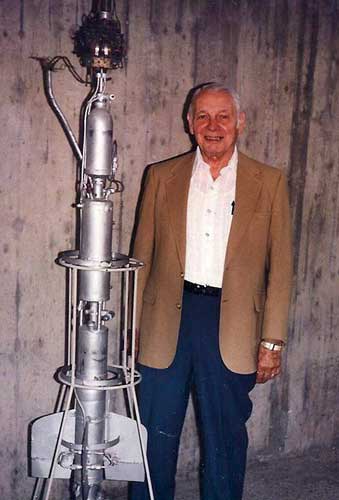Konrad Dannenberg: German rocket engineer who helped to develop Saturn V

Konrad Dannenberg was key to the NASA space programme which enabled Neil Armstrong and Buzz Aldrin to land on the Moon in 1969. Though deeply involved in the development of Nazi military rockets, he claimed he was only ever interested in man conquering space.
Dannenberg was born in 1912, in Weissenfels, near Leipzig. His family moved to Velber, outside Hanover, when he was two years old, and he grew up there. He caught the space bug while attending a lecture by Max Valier, the Austrian astronomer and rocket pioneer and was also impressed by a test of Fritz Von Opel's rocket-powered automobile. These experiences led him to join Albert Püllenberg's circle of independent rocketeers in Hanover. Püllenberg wanted to use rockets to deliver mail to the North Sea islands and launched the first liquid-fuelled rocket to this end in 1934. His attempts failed.
Dannenberg studied mechanical engineering at Hanover University, but when the Second World War broke out in 1939 he was called up for service in the army. As an army officer he saw active service during the French campaign. In the autumn of 1940, through the influence of Püllenberg, he was released from the army and transferred to Peenemünde, becoming a rocket engine specialist under Dr Walter Thiel.
The remote fishing village of Peenemünde, on the Baltic island of Usedom, had been chosen by the Nazis as the site for the development and testing of military rockets. The military commander was Major, later, General Walter Dornberger, himself a qualified engineer.
Dannenberg's main assignment was the development of the 25.4 thrust engine for V-2 rocket production. Fortunately, many of the amendments he worked on could not be completed in time for production. After Thiel's death in a bombing raid of August 1943, a design freeze stopped all further development. He then became Walter Riedel's deputy and led the frantic effort to finalize production drawings of the V-2 rocket.
In an interview with the Associated Press on the 30th anniversary of the first moon landing, Dannenberg said that of all the rocket launches, the test launch of the V-2 on 3 October 1942 stood out the most. It soared 53 miles high, just past the 50-mile point where space begins. It was the first rocket to break that barrier. Dornberger apparently proclaimed that day as 'the first of a new era in transportation, that of space travel.' No doubt inspired, Dannenberg, Püllenberg, Werner von Braun, and their colleagues worked hard to perfect their projectiles.
On 13 June 1944, the first V-1 flying bomb was launched in the direction of London. It came down in Bethnal Green, killing six people. Within hours many more of these Vergeltungwaffen (revenge weapons) were launched from the still-occupied France. The final two fell on 29 March 1945. By then, several thousand had been fired, killing 6,200 people and injuring many thousands more. German rockets also hit targets in Belgium and France. Among the worst raids on London was the explosion in a Woolworths department store in New Cross, killing 168. In Belgium, 567 died in a cinema in Antwerp.
As the Allies approached Peenemünde, in April 1945, about 500 handpicked rocket experts and technicians were moved, on Heinrich Himmler's orders, to the Bavarian Alps. Eventually, Werner von Braun sent his brother, Magnus, by bike, to find the Americans. The US Army gave them safe passage and on 2 May 1945, von Braun and his team surrendered to the US 44th Infantry Division. The Soviets captured the deserted Peenemünde site. Perhaps as many as 20,000 prisoners had died producing the deadly weapons. Dornberger, who had had to step aside later in 1944 as the SS took over ultimate control of the project, was detached from his comrades and handed over to the British as a potential war criminal. However, two years later, he was released to join the exodus to the US and was later honoured for his activities there and in Germany.
In late 1945, together with Werner von Braun and 116 others, Dannenberg was whisked off to the US as part of the secret Operation Paperclip. As of January 1947, he was working for the US at Fort Bliss, Texas.
He later helped to develop and produce the Redstone and Jupiter missile systems for the Army Ballistic Missile Agency at Redstone Arsenal. He joined NASA's Marshall Space Flight Center as deputy manager of the Saturn program in 1960. This was in the year after the Russians had successfully completed two unmanned Moon landings.
Later, Dannenberg received the NASA Exceptional Service Medal for successfully developing the largest rocket ever built. Saturn V was a multistage liquid-fuel expendable rocket used by NASA's Apollo and Skylab programs from 1967 until 1973. Altogether, NASA launched 13 Saturn V rockets with no loss of payload. With Apollo 11, von Braun, Dannenberg and their colleagues put Armstrong and Aldrin on the Moon on 20 July 1969.
Dannenberg received much recognition for his work and took up a number of appointments after leaving NASA in 1973. Among them, he was appointed Associate Professor of Aerospace Engineering at the University of Tennessee Space Institute (UTSI) in Tennessee and was a Fellow of the American Institute of Aeronautics and Astronautics. He was the recipient of the 1960 Durand Lectureship and the 1995 Hermann Oberth Award.
He never showed any remorse for the deaths he had caused, or those he had helped to cause: those who had made history, he attested, were responsible, not him.
David Childs
Konrad Dannenberg, rocket pioneer: born 5 August 1912 Weissenfels, Saxony-Anhalt Germany; married Ingeborg M. Kamke (deceased; one son), married Jackie E. Staiger; died Huntsville, Alabama 15 February 2009.
Join our commenting forum
Join thought-provoking conversations, follow other Independent readers and see their replies
Comments